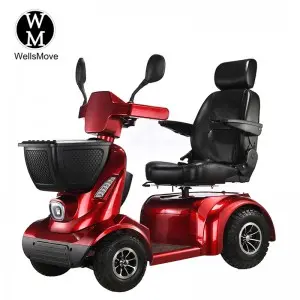Troubleshooting guide for electric scooters for the elderly when the motor does not rotate
In the process of using electric scooters for the elderly, it is inevitable that the motor will not rotate. This will not only affect travel plans, but may also cause anxiety and uneasiness to users. This article will elaborate on the troubleshooting methods when the motor of electric scooters for the elderly does not rotate, aiming to help users quickly find the problem and solve it in time.
1. Preliminary inspection
Check the power supply: First, make sure that the battery has enough power. Check whether the battery voltage is normal by checking the power indicator or using a battery tester. If the battery is low, it should be charged in time. At the same time, check whether the battery connection wire is firm, loose, oxidized or damaged. If there is a problem with the connection wire, clean it and tighten it.
Check the power switch: Turn on the power switch, listen for a “click” sound, and observe whether the indicator light on the dashboard is on. If the indicator light is not on, it may be a power switch failure. You can try pressing the reset button of the power switch (if there is one), or use a multimeter to measure the input and output voltages of the power switch to determine whether the power switch needs to be replaced.
Check the fuse: Find the fuse box on the scooter, which is usually located near the battery or near the controller. Check whether the fuse is blown. If it is, replace it with a fuse of the same specification. But be careful, if the fuse blows frequently, there may be a short circuit or other fault in the circuit, which needs further investigation.
2. Controller inspection
Check the appearance of the controller: Check whether there are obvious signs of damage on the surface of the controller, such as burning, deformation, cracks, etc. If so, the controller may need to be replaced.
Check the controller wiring: Carefully check whether the connection wires between the controller and the battery, motor, speed control handle, brake handle and other components are firm, loose, virtual connection, or short circuit. You can gently pull the connection wire by hand to feel whether it is loose, and check whether the wire head is oxidized or corroded. If there is a problem, you need to reconnect or repair the wiring.
Check the controller parameter settings: Some controllers have specific parameter settings, such as speed limit, current limit, etc. If the parameters are set improperly, the motor may not start normally. You can refer to the controller’s manual to understand how to set its parameters, and use professional testing equipment (such as a controller debugger) to check and adjust the parameters.
3. Motor inspection
Check the appearance of the motor: Observe whether the motor housing has any damage such as collision, deformation, water ingress, etc. If there is obvious damage, the motor may need to be replaced.
Check the motor wiring: Check whether the connection between the motor and the controller is firm, and whether there are any loose, broken, short-circuited, etc. At the same time, check whether the Hall wires of the motor (usually yellow, green, and blue wires) are in good contact. You can use a multimeter to measure the resistance value of the Hall wire. Under normal circumstances, the resistance value of each phase should be similar. If the resistance value of a phase is abnormal, it may be that the Hall element is damaged, and the motor or Hall element needs to be replaced.
Check the operation of the motor: On the premise of ensuring safety, you can try to turn the hub of the motor by hand to feel whether there is resistance, abnormal sound or jamming. If the motor does not rotate smoothly, it may be that the bearing inside the motor is damaged, the magnetic steel falls off, or foreign matter enters, and the motor needs to be further disassembled for inspection and repair.
4. Check the speed throttle and brake handle
Check the speed throttle: Open the outer shell of the speed throttle and check whether the internal potentiometer is damaged. You can use a multimeter to measure the output voltage of the speed throttle. When the throttle is turned, the output voltage should change between 0.8V-4.2V. If the voltage does not change or changes abnormally, the speed throttle may be damaged and needs to be replaced.
Check the brake handle: For scooters with brake power-off function, check whether the brake handle is reset well. When the brake handle is pulled, the brake switch should be able to close normally, and it should be able to reset automatically after releasing the brake handle. If the brake handle fails, it may cause the motor to fail to start or suddenly lose power. The brake handle needs to be replaced or its circuit repaired.
5. Other inspections
Check the brake system: In addition to the brake handle, it is also necessary to check whether the brake shoe is severely worn, whether the brake disc is loose or deformed, etc. If the brake system fails, it may affect the normal operation of the motor and even cause safety accidents.
Check the tires and wheels: Check whether the tires are leaking, excessively worn, and whether the wheels are loose or deformed. Although these problems may not directly cause the motor to stop rotating, they may affect the driving performance and safety of the scooter, and indirectly cause motor failure.
Check the body and frame: Check whether the body and frame are severely deformed or cracked, which may affect the overall structural stability of the scooter and even cause damage to the motor and other components.
6. Common fault codes and troubleshooting
Some elderly electric scooters have fault indicator lights or fault code display functions on their controllers. When the motor does not rotate, the fault code can be used to quickly locate the problem. The following are some common fault codes and troubleshooting methods:
Battery voltage is too low fault code: If the controller displays a red light flashing once, it means that the battery voltage is too low. At this time, check whether the battery power is sufficient and whether the charging system is working properly.
Motor fault code: If two red lights flash twice, it means that the motor is faulty, which may be caused by motor jamming or coil burnout. It is necessary to follow the above motor inspection method for troubleshooting.
Brake fault code: If the light flashes 5 times, it means that the brake is on or the brake fails. It is necessary to check whether the brake system is working properly and whether the brake switch is reset well.
Speed regulator fault code: If the flashing light is 6, it means the speed regulator is faulty. It may be that the speed regulator fails or the plug of the main line connected to the speed regulator has a problem. The speed regulator and related wiring need to be checked.
7. Summary
When the motor of the elderly electric scooter does not rotate, it should be checked in order from simple to complex, from appearance to interior. First check the basic components such as power supply, power switch, fuse, then check the key components such as controller, motor, speed regulator, brake handle, and finally check other factors that may affect the operation of the motor. During the investigation, observe carefully, analyze carefully, and use appropriate tools and methods for testing. If the user cannot solve the problem by himself, he should contact professional maintenance personnel or manufacturer after-sales in time to ensure the safe and reliable operation of the scooter.
8. Preventive measures
Regular maintenance: Regularly maintain the elderly electric scooter, including checking the working status of components such as batteries, controllers, motors, etc., cleaning dust and dirt on the body and components, and tightening loose screws and nuts.
Correct use: Avoid using the scooter for a long time during use, especially in harsh environments such as high temperature and high humidity. Follow the operating procedures, do not overload or overspeed, and use the brake system reasonably. Timely maintenance: Once a scooter is found to have a fault or abnormality, it should be repaired in time to avoid the fault from expanding and affecting the normal operation of the motor and other components.
Post time: May-07-2025



